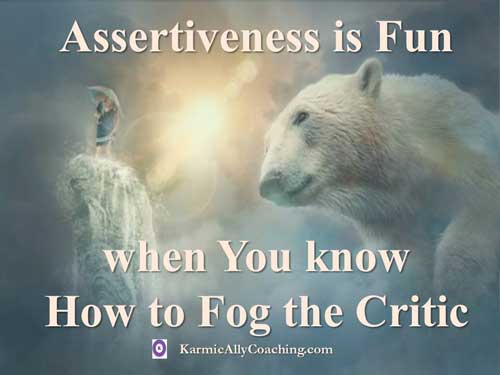This post has already been read 3804 times!

Have you ever had a critical boss, colleague or “friend” who has managed to put you down in such a manner that no one noticed it apart from you?
Think hard, has there ever been a time when you have been receiving so-called constructive criticism or well-wisher advice that has left you knotted in the stomach?
Or confused you when you replayed the conversation wondering whether your response was adequate and appropriate to the situation?
Do You recognize Passive-Aggressive Communication when it’s staring you in the face?

Quite possibly you have been subjected to Passive-Aggressive communication with mixed messages that can easily trip even the most assertive individual.
This style of indirect communication is quite destructive. It’s often not easy to identify as the body language may not match the tone or choice of words.
Sometimes the comment may be funny or full of sarcasm. Warning bells should sound if you are receiving mixed messages which are leaving you confused or making you resentful.
You might be dealing with a toxic colleague.
Then it is time to take action before your self-confidence takes a hit.
One example that I remember from my teen years happened to a friend which illustrates the point.
“I love your almond shaped eyes; they take attention away from the acne on your cheeks”.
On hearing that statement she was completely stunned – was it a compliment or a jibe?
Hours of girl-talk later, we were not sure but felt it was criticism and knew she should have responded. If only we had known, about the assertiveness skill of fogging to diffuse criticism and prevent conflict.
How to master the assertiveness skill of fogging

Fogging is based on agreeing with your critic like a fog bank. Here, we look at the criticism as feedback accepting that it is only that person’s opinion. Your own opinion about yourself is the one that matters.
But what if there is some truth in what the other person is saying, however sloppily it is communicated?
Instead of launching into a defensive attack or arguing, would it not be more productive to try to get to the root of what is being communicated?
With fogging you acknowledge what the critic is saying or some part of it which may be true.
You may not agree with what is being said as relating to you, but you agree with the possibility that what they say is true.
In other words, you absorb the criticism without getting defensive. You stay calm, leading to further dialogue as the other person feels they have been heard.
You can also ask the critic to clarify their assertion thus putting the burden on the critic to explain themselves.
Don’t be surprised if the critic backs off.
It is quite exhausting to continue criticizing someone who is not reacting in the manner the critic would like.
In my friend’s case the options would have been:
- If she felt, there was some truth in the statement. You’re right, my eyes do take attention away from the acne on my cheeks
- If she didn’t agree with the criticism but was willing to admit to the possibility of the critic being right. Sometimes my eyes and other features do deflect attention away from the acne on my cheeks
- If she didn’t agree with the criticism, she could simply admit to the principle of the criticism. Sometimes it helps to have other features to cover for the flaws on a person’s face
Past the absorption stage the next step would have been to ask for clarifications. Like, what should one do about the acne?
My friend might have learned something useful about acne treatment or better yet, the critic might have backed off!
In such a situation, which option would you use?
PS. Carrying off this assertive technique requires self-assurance and confidence. If you feel you need help in that area, please do check out my Kindle book – Self Confidence in 8 Steps.
Know someone who is suffering from criticism and needs a strategy to tackle the aggressor? Please share this post with them using the share buttons below. Thanks!
Written By: Vatsala Shukla




 I adhere to the Certified Coaches Alliance Code of Ethics and Standards. A copy is available on request.
I adhere to the Certified Coaches Alliance Code of Ethics and Standards. A copy is available on request.
 Let's Talk through the Connect Form:
Let's Talk through the Connect Form:
I really appreciate this post, Vatsala. No matter how far past our acne years we may be, we still have to deal with critics and criticism. I really like your approach of putting the onus back on the critic to explain and elaborate their meaning.
Putting the onus back on the critic is a good way to stop unnecessary criticism in its track and more importantly, it is a form of feedback to the critic to be more articulate so that the receiver is able to comprehend what is being said. Glad you liked the post, Reba.
Such scenario is so common in workplace. Thank you for bringing awareness to this subject as it is not much talked about. I totally relate to passive-aggressive colleagues. Fogging seems to be a good take on it. I love the term ‘fogging’ .. such a beautiful metaphor .. easy to remember!
Thanks Jonita. The best part is that it works!
Just love the graphic Vatsala. Yes I remember that passive aggressive critic from past work life experience. How would I react now- first i would look to see if there was any truth in the statement- was there a mirror for me- scary but just maybe. If not I would use the fog techniques you described- love it xxx
Constructive feedback is always welcome but passive-aggressive behavior is a big No No, Suzie. It is scary to think there might be some truth in what the other person is saying but we wouldn’t hear it if it is coated in the wrong manner. I’m glad you liked the technique.
I think that when passive-aggressive behavior towards you first happens, it catches you by surprise and you don’t know how to respond. But, this fogging technique is a golden technique in how to respond. Agreeing (in part) with someone always takes the edge off of things, but asking the “what should I do?” put the onus back on them.
I love the thought of putting the onus back on the other person to tell us what to do, Joyce. It would lead to a constructive dialogue or even better, stun the critic!
Passive aggressive communication is the worse– and sometimes when you call them on it they act all innocent. Uggh- i feel knots in my stomach just thinking about it.
It is indeed a bad form of criticism, Karen, because it leaves the recipient wondering whether they have been criticized or if it is their imagination playing tricks. Thank God there is a technique to turn the tables and that too with dignity. Thanks for visiting my blog!
I have met a few of the people that fits into your description. At times it is difficult to stay calm at the moment. Good subject to think about.
Welcome to The Karmic Ally Coaching Experience Blog, Eva. I absolutely agree with you. It is difficult to stay calm but once we learn this technique, it is easier to ward off unwarranted criticism.
This is all very familiar and brings back memories of my last boss who attempted to shatter my confidence while still pretending to be a lovely person. The very reason I no longer have a boss and made the leap to become a sole trader. Having the ability to see through such behaviour sure does help.
We all have such experiences somewhere in our lives, Holly, and when it happens, it is not fun. The best part about this technique is that it not only helps us to remain assertive but can throw the person who is criticizing us into a loop until they realize that their objective of breaking us is not succeeding. Thanks for dropping by!